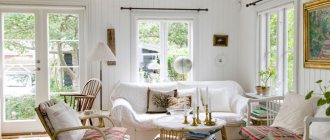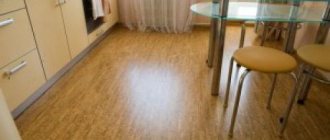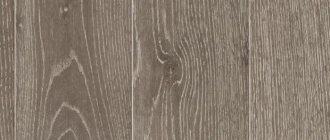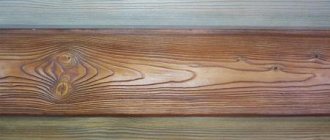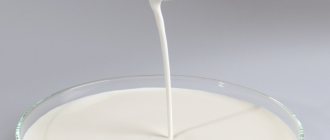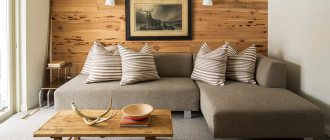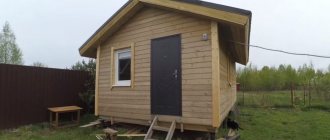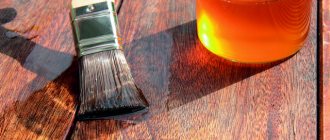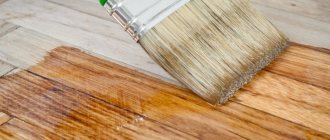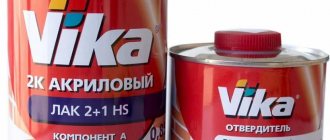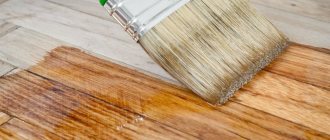The wooden base must be protected from a number of negative factors, then the material will delight the eye for a long time with its beautiful appearance and durability. For this purpose, varnishing is often used; aqua varnish is considered a safe and high-quality option. This is not a brand name, but a type of varnish that is distinguished by its water-based creation, which makes it safe, and also receives a reliable film coating. Aqua varnishes for wood, what they are and how to use them correctly will be described below.
Choosing the color and gloss of aqualak for wood
One of the advantages of water-based varnish is its rich range of colors. You can choose the shade you like, and if you wish, do some coloring. This ability of the product allows you to preserve the natural structure of the wood and emphasize it.
Use selections or catalogs that the company can provide. There you can select and change characteristics such as depth, composition and saturation of shades.
Part 2. Secrets of varnishing parquet
How to avoid defects when varnishing parquet
In accordance with international DIN standards, the surface of the varnish film is accepted from the height of human growth from top to bottom in diffused light. In this case, you should not kneel down and use artificial lighting sources (backlight) when assessing quality. About 30% of all complaints about finished parquet floors relate to varnish. It often happens that the customer places excessive demands on the varnish coating, expecting industrial “furniture” quality. This does not take into account that varnishing is done manually and sometimes in unfavorable conditions of the construction site.
Despite all the efforts of parquet workers, there are no rooms with an absolute absence of dust, such that the smallest specks of dust do not settle on a fresh varnish coating. Individual brush hairs or small inclusions in the varnish film are acceptable and cannot be avoided. The customer needs to treat such minor defects with understanding, because they do not have any effect on the overall durability of the coating. But it goes without saying that these relaxations do not apply to significant defects.
The surface should be varnished evenly. However, the requirements for the same thickness of the varnish layer are not legitimate due to the different absorbency of wood. The film should not have large roughness, sagging, distinct edges of varnish stripes, or missing areas. The coating must have the same gloss. To ensure that the final result of the work does not disappoint either you or your customer, before applying parquet varnish, you must carefully study the manufacturer’s recommendations and accompanying technical documentation, pay attention to the restrictions on the use of the product and the compliance of its shelf life with technical requirements. If during the application of the varnish coating obvious defects related to the quality of the varnish are discovered, work should be suspended and the manufacturer or seller should be informed about the incident. With a trusting relationship between the seller and the buyer, good work results can always be achieved.
The varnish should be applied in strict accordance with the manufacturer's recommendations. You need to start applying varnish immediately after sanding the parquet. Currently, the following methods of applying varnish are common: manual (with a swab, brush, spatula, roller) and mechanical airless spraying with a spray gun. Basically, only the primer or first coat of varnish is applied with a spatula. The following layers should be applied with a brush or roller. If the varnish is applied with a spatula, then the passages in any case should be oriented crosswise to each other. This means that if the first passage was along the room, then the second should be across. Strokes with a spatula are usually made in an S-shaped motion. The advantage of this method is that the varnish coating is more durable. At the same time, the joints of adjacent sections are masked. Since the absorption of varnish into the wood with this method of application is insignificant, the wood acquires a light tone.
The brush for applying varnish should be wide. Brush strokes are usually made in a U-shaped motion. Due to this, an overlap of the adjacent area is achieved and at the same time no thickening of the varnish layer is formed. At one time, the varnish should be applied to an area of such size that the brush is always in contact with the freshly applied edge. After working with two-component varnishes, the brush must be washed with a solvent so that the remaining varnish on the brush does not harden. During breaks when working with one-component varnishes, the brush can be kept in a container with varnish. During long breaks or transportation, this container should be closed.
If the varnish is applied using a roller, the direction of movement during work should always be oriented crosswise. When moving across, the varnish is applied, when moving along, it is leveled. When leveling, the roller should only make back-and-forth movements, after which it rises, moves by about 3/4 of its width - and the cycle of back-and-forth movements repeats. Near walls, the pace of movement should be reduced so as not to accidentally touch the wall. When applying varnish with a roller, you should never make an M-shaped movement. This is caused by the risk of shadow-like thickenings appearing on the varnished surface.
If the roller has been in a bath of varnish for a long time, it must be thoroughly rolled out before resuming work, since otherwise droplets may form when applying the varnish.
Areas of application for scuba diving
The versatility of this protective varnish lies in the fact that it is suitable for both external and internal work. Of course, you will need to comply with certain conditions in both cases, but the result will be worth the effort.
The main condition is low air humidity. Due to excessive moisture, the varnish will apply unevenly, resulting in unsightly smudges and uneven spots at the joints.
Those types that are declared as ultraviolet are used as a protective layer for building facades, wooden gazebos, benches and other elements.
Leading manufacturers of water-based varnishes
To get the desired result, you will need not only to follow the operating technology, but also to choose a suitable scuba tank that will last a long time. There are products on the construction market that have received many positive reviews:
- Akzo Nobel, produced in Sweden, the use of a parquet look is popular;
- Sigma Coatings, also a good Dutch wood coating product;
- Eurotex, a Russian brand that offers good products at reasonable prices;
- IMPRANAL, the Czech brand stands out for the production of varnishes that can be used on substrates that are in constant contact with water;
- Teknos note a high level of wear resistance of the coating.
To get the desired result, you will need not only to follow the operating technology, but also to choose a suitable scuba tank that will last a long time.
Aqua varnish is able to quickly cover a wooden base and create reliable protection from external loads. It is important to choose a high-quality type that is suitable for operating conditions. When working, you need to perform the technology, applying layers quickly in order to obtain a uniform and beautiful coating. Then varnishing with your own hands will be successful.
How to apply Aqualak correctly
Water-based varnish is used in both interior and exterior work. One of the few fundamental factors for its use is the minimum air humidity.
The material does not absorb well into the wood surface if it is wet. In addition, the varnish can penetrate deep into the wood very unevenly, which is why unevenness, stains and even smudges may appear on the surface of the treated products.
The varnished surface should be kept away from water. Try to limit contact with liquid and keep it to a minimum. But this does not replace periodic wet cleaning. It is enough to prepare a soap solution and clean the products with it. Try to use non-aggressive means.
To treat the floor surface, it is better to choose a different type of varnish. One of the reasons for this decision is more intensive use, which causes the coating to wear off much faster.
Applying the coating is not as difficult as it might seem. To do this, it is also worth fulfilling several important conditions to ensure the longevity of the result:
- The surface of the product must be coated from top to bottom. Do this without interruption. Since the product dries almost instantly, you need to follow this advice. Otherwise, uneven stripes will form, which will appear after drying.
- Before you start painting, mix the aqualac thoroughly. Dilution with water is not a mandatory step, but it is not prohibited if necessary. The best application option is to paint with a brush in at least 2 layers. Thanks to this, you can protect the surface of the wood, as well as give it a more expensive and high-quality appearance.
- After a certain period of time, the varnish coating will become even stronger. However, it is advisable to use with caution during the first two months. Wet cleaning must be done carefully. This is necessary to avoid the formation of scratches or chips.
Main types and composition
The separation of varnishes is carried out based on their constituent elements. This feature affects the technical characteristics. To make the right choice, you should understand the characteristics of the species.
The separation of varnishes is carried out based on their constituent elements.
One-component
This option involves creating a varnish from a single polymer; the use of acrylic is in demand; sometimes polyurethane-based products can be found.
The second type is more affordable, but its characteristics are less effective in protecting the tree. It is also noted that the use of types on polyurethane is limited; for this reason, when purchasing, study the manufacturer’s recommendations in advance, indicating the operating rules.
This option involves creating a varnish from a single polymer.
Two-component
Varnishes consisting of two components are considered more universal. There are even options that can be used for parquet boards and other flooring materials; they are distinguished by better wear resistance.
Aqualak for wood for interior work is most often chosen, but in this form there are products with a high degree of resistance, suitable for updating surfaces and in rooms with high levels of humidity.
Varnishes consisting of two components are considered more universal.
Step by step varnishing process
For a high-quality coating, several important conditions must also be observed, which will be outlined below.
The total number of layers with which the product will be coated directly depends on the required strength, as well as the type of wood. More details can be found in the instructions included with the varnish.
- When painting, avoid direct exposure to the sun's rays on the newly coated surface. And also make sure that there are not even the slightest drafts in the room. All this will negatively affect the quality of the coating. The process must take place under certain conditions. Work quickly and carefully, following technology.
- For an even color, coat the entire piece at once. By working in fragments, you risk getting obvious lines due to uneven layers. Also, due to this approach, a phenomenon such as multi-shade may appear.
To obtain a perfect, even surface, sand the previously applied layer before applying the final coat. This is done using sandpaper. Afterwards, clean the surface thoroughly. To finish and get an excellent result, cover the product with a couple more layers.
Matte and glossy water-based varnishes
A varnish coating often serves for decorative purposes; the ability to create a moisture barrier on a wooden base is not always paramount. In this case, it is important what effect will be obtained after drying - matte or glossy.
Since each board has its own unique pattern, owners usually want to emphasize it without completely covering the material with color. But the interior may require a different shade; the colors for the lining may be different; applying a layer tints the surface, giving the desired shade.
The matte surface is softer and silkier to the touch, creating a velvet effect. Gloss can be achieved in varying degrees, and maintenance on a smooth surface will be easier than on a rough matte surface.
To achieve gloss, you will need to apply a multi-layer coating; a matte surface is obtained by a small number of layers of varnish.
Gloss can be achieved in varying degrees, and maintenance on a smooth surface will be easier than on a rough matte surface.
For which rooms is aqualak suitable?
As mentioned earlier, the strength of the scuba tank is usually not high enough, but the acrylic version will solve many problems. It is perfect for rooms with different microclimates. It is resistant to temperature changes and also tolerates high humidity. Thanks to this, it will become a solution for saunas, baths or swimming pools.
In addition, the material can be used outdoors. It is suitable as a protective layer for stairs, building facades, fences, etc. Due to its properties, the varnish dries quickly.
Part I. Modern parquet varnishes: their properties and applications
When choosing a varnish (usually the varnish for parquet work is chosen by the performer - the parquet master, taking into account the wishes of the customer), it is necessary to take into account its most important technical characteristics, which, as a rule, are given in the description. The determining factor when choosing a varnish is the purpose of the room and the expected load on the parquet. If the room will be used by a small number of people and they will wear light house shoes, then you should choose a floor varnish with normal load. For non-residential premises where people actively walk in outdoor shoes, varnishes for floors with increased load are recommended.
In non-residential premises with high traffic (bars, restaurants, museums, shops, etc.), it is preferable, instead of covering parquet floors with varnishes, to rub them with water-repellent compounds - oil impregnations or wax mastics. Thanks to this, the useful layer of the parquet strip remains in good condition for a long time, because when rubbing with oil or wax, the parquet is not sanded, as when varnishing. (For example, the parquet flooring in the Ostankino Museum, which is a work of art, was preserved in good condition for more than 100 years thanks to a constantly renewed wax coating.)
Parquet varnishes are classified according to:
- chemical composition: water-soluble, based on artificial oil resins (alkyd and urethane-alkyd), water-free polyurethane (DD, PUR varnishes), acid-curing or formaldehyde resin-based (SH varnishes), primers;
- technological properties (for example, by method of application, viscosity, fluidity);
- resistance to operational loads (i.e., resistance to mechanical loads, external environments, light) and service life;
- qualities that affect the appearance (for example, the ability to paint wood, i.e., the degree of purification from turbid impurities, transparency);
- gloss levels: matte, silky-matte, semi-matte, semi-gloss, glossy;
- degree of environmental friendliness and recycling possibilities.
With the advent of tinting technology, there are practically no restrictions in choosing the color of parquet varnish, and colorless varnishes are becoming a thing of the past. Customers and parquet workers have ample opportunities to update their interiors, since after 3-4 years the customer can change the color of the varnish to a completely different one, choosing from more than 2000 shades. On average, varnish consumption when applied in one layer is 8-10 m2/l. However, parquet flooring is covered with at least three layers, not counting the primer coating. When working with varnishes, it is recommended to use a respirator. The temperature of the floor and air during the application of varnish should be no less than 15 and no more than 22 C. Particular attention should be paid to heated floors. The operational readiness of the last layer usually occurs after 24 hours. The duration of its exposure before intensive use is from 3 to 14 days and depends on the temperature of the floor and the environment and the relative humidity of the air in the room. This means that you can walk on the floor within 24 hours after applying the last layer, and bring furniture into the room only after waiting for final polymerization (for this, a coin test is performed).
Lacquered parquet floors must be protected from direct sunlight, low air humidity and lack of ventilation. Otherwise, over time, the varnish film will lose its hardness, become soft, pliable, and tears may appear on it. Air humidity in the room should be no lower than 50% and no higher than 70%, temperature - no less than 15 C, air exchange rate - no less than 50 l/min. In rooms with large differences in temperature and humidity, it is advisable to use oil or wax mastics. It is advisable to wipe varnished parquet with a well-wrung out damp cloth. Caring for matte and silky-matte varnish is much easier, because when sunlight hits the surface of the film, traces of grease and small scratches are not visible. To remove stains from shoes, ink, dirt, grease from semi-matte, semi-gloss and glossy coatings, use special solutions and polishes. It is advisable to stick felt heels on furniture legs to reduce the point load on the varnish film. You cannot walk on varnished floors in street shoes, especially high-heeled shoes - cracks, dents, and chips may appear on the parquet floor. The varnish coating on worn areas of the floor must be restored in a timely manner. Waterproofing properties cannot be attributed to varnishes - they are only vapor barriers. If the humidity of the walls (more than 5%) and air (more than 80%) in the room is significantly exceeded or there is a serious leak, the moisture will still sooner or later penetrate into the parquet, no matter what varnish it is coated with. If moisture accidentally gets on the varnish strip, then the floor surface must be wiped with a cloth as quickly as possible so that the water does not have time to penetrate the parquet.
There are varnishes with increased resistance to water and environmental influences. They are intended for covering decks, boats, etc. Their wear depends on the intensity of exposure to moisture and the number of layers of coating.
Now let's move on to a detailed description of the five main groups of varnishes, different in chemical composition.
Water-soluble varnishes for parquet
Water-soluble varnishes in most cases are dispersions. The dispersion is formed by small-sized droplets of the binder, evenly distributed throughout the volume of water. To achieve small droplet sizes and their uniform distribution, a high-speed stirrer is required. Water and a binder are poured into the container for preparing the dispersion, then when adding emulsifiers, all this is mixed at high speed until the mixture stops stratifying. After this, a small amount of solvent is added as a film-forming component. As a result, small droplets of binder are formed with adjacent particles of emulsifier and solvent, which are surrounded by water. Due to the peculiarities of preparation, water-soluble varnishes dry differently than varnishes with a large amount of solvent. After applying the varnish, water first begins to evaporate. The film-forming component evaporates much more slowly, so its concentration in the dispersion constantly increases. When a certain threshold concentration value is reached, the film-forming component begins to dissolve the binder droplets (as they say, the binder droplets “melt”). Only after this does the film-forming component completely evaporate. The varnish film dries and hardens.
Water-soluble varnishes have good adhesive properties when applied to wooden surfaces and form a viscoelastic film. Based on the solvent content, they are divided into three categories: containing no solvents at all, containing solvents up to 5 and up to 15%.
When storing varnish, do not allow it to freeze. When applying it, the ambient temperature must be higher than the minimum permissible (15 C). Water-based varnish has the negative property of gluing the side joints of parquet films. Its adhesive properties can be reduced by using a primer, but cannot be completely eliminated. The positive properties of water-soluble varnishes include a very low concentration of solvent vapors in the air at the time of application. The smell of such varnish in the room is felt to a lesser extent than when working with anhydrous chemicals, so water-based varnishes can be used in rooms where people who are not involved in this process are present at the time of coating. These varnishes are non-flammable, they can be used where, according to construction conditions, the use of varnishes with solvents is impossible due to the risk of fire or explosion. The negative properties of water-based varnishes include their relatively low wear resistance compared to anhydrous polyurethane and acid-curing groups. To increase their wear resistance, manufacturers are forced to add special additives to varnishes. Thus, the binder of water-based varnish for floors with normal loads can be polyurethane acrylic dispersion, for floors with increased loads - a modified polyurethane dispersion based on fatty acids. At the time of application, water-based varnishes are sensitive to the microclimate of the room.
In order for the polymerization reaction to proceed normally, they require relatively stable air humidity in the room (at least 50%), and this is not always possible to ensure, especially in winter, when central heating is on, and if there are no humidifiers in the room.
As a rule, water-based varnishes are also demanding of the proprietary tool - rollers - and do not like it when they are applied with a swab, spatula, or brush. Since these varnishes have a water residue, it is not advisable to coat them without a primer, especially on “nervous” species: beech, hornbeam, pine, merbau, etc. A primer is usually included with the varnish by the manufacturer. It helps protect the edges of the parquet planks from warping (to prevent the formation of torn edges on the parquet plank, increasing the wood fibers).
Varnishes based on artificial oil resins
The binder for varnishes based on artificial oil resins are alkyd resins, which are produced from natural raw materials, for example, linseed or wood oil. These natural oils allow the varnish to penetrate deeply into the wood.
Polymerization reactions involving products obtained from natural raw materials are very complex. Simplifying these phenomena, we can imagine the process of drying the varnish layer as follows. After applying alkyd varnish, the solvent, white spirit, first begins to evaporate. Only after a significant portion of the solvent has evaporated does the chemical polymerization reaction begin. In this case, the double chemical bonds in the monomer molecules are broken, and the latter are combined into polymer chains that bind to each other and form a spatial network.
The polymerization reaction becomes possible because the molecules of alkaline resins have double chemical bonds. At the beginning of the reaction, the molecules are close to each other. When the solvent evaporates, oxygen from the air diffuses into the first liquid and then adhesive-like varnish film and is located between the alkyd resin molecules. As a result, the molecules begin to react with each other and increase in size. The varnish film first becomes glue-like, and then within 8-12 hours at a temperature of 20 C and a relative air humidity of 50% it finally hardens. Depending on how much solvent has evaporated, the thickness of the varnish layer also decreases. Urethane-alkyd and alkyd varnishes change the natural color of wood, “set fire” to the wood, emphasizing its texture and texture. The hardened varnish layer has the appearance of a horn-like film, which is elastic and at the same time non-slip.
There are alkyd varnishes with high and low concentrations of white spirit. Varnishes with low diluent concentrations are less toxic. The varnish “sets fire”, enhances the natural color of the wood, and emphasizes the texture of the fibers.
The positive properties of alkyd varnishes include the fact that they do not have adhesive properties. If, during the application of varnish, it flows into the gap between the parquet planks, then these planks will not stick to each other.
Alkyd varnishes are used mainly when there is no point in interfering with the natural process of changing the geometry of individual parquet planks in a room due to strong vibration loads, temperature changes and air humidity: when covering plank floors, end parquet, parquet laid on a heating screed (in-floor heating systems) , “floating” floors, parquet made of “nervous” rocks that quickly respond to changes in air humidity in the room, floors in gyms, etc.
The disadvantages of alkyd and urethane-alkyd varnishes include their special sensitivity to drying conditions at elevated air temperatures (during central heating, lack of ventilation) and the surface being treated (due to heating by sunlight, in-floor heating systems, lack of curtains on the windows). Here you may encounter a significant slowdown in the drying process of the varnish. At the same time, a supply of fresh air must be provided, since oxygen is needed to cure the varnish. It is necessary to strictly ensure that one layer of varnish is not applied in quantities exceeding 120 g/sq.m. When applying excessively thick layers, a wrinkled surface may form. The wear resistance of oil-based varnishes is considered worse than that of water-based, water-free and acid-based polyurethane varnishes. According to the degree of gloss, varnishes are matte, silky-matte, semi-matte, glossy.
Waterless polyurethane varnishes
These varnishes are characterized by exceptionally high adhesive properties to wood. At the same time, the varnish film becomes viscoelastic and has increased resistance to chemicals. Due to these chemical characteristics, polyurethane varnishes are used in rooms subject to particularly heavy loads associated with intensive movement on the floor and chemical influences, for example, drinks, cleaning agents.
There are one-component and two-component polyurethane varnishes, known as PUR and DD varnishes. These varnishes are divided into those containing and not containing aromatic compounds. They have different bases: acrylic, urethane, solvent-based.
First, like all varnishes, they dry physically, that is, due to the evaporation of the solvent. After this, chemical hardening begins, which occurs in the form of a polyaddition reaction. In this reaction, different molecules having reactive groups enter into a chemical bond with each other. In the case of polyurethane varnishes, the main component has a reactive OH group, and the hardening component has an AMCO group. As a result of the polyaddition reaction, chain molecules appear in the polyurethane composition, structured with cross-links, which leads to the formation of a macromolecule.
At the time of coating and at the curing stage, the varnish film must be protected from contact with moisture; before starting work, it is necessary to check that the wood moisture content does not exceed 10-12%. If the hardener reacts with water, CO2 appears as a by-product, which, released in gaseous form, causes the formation of air bubbles in the film, bubbly foaming of the varnish layer, which leads to coating defects.
Depending on the base, a proprietary thinner is included with the waterless varnish. As a rule, these varnishes do not require primers, and the first layer of varnish does not raise wood fibers. Varnishes are not as capricious to the microclimate of the room as water-based and alkyd varnishes; they can preserve the natural color of the wood or “set fire” to the surface. They have excellent elasticity, good light and heat resistance, and can be applied to coatings exposed to water and other external environments (bathroom and kitchen furniture, garden furniture, table tops, stairs, railings, doors). Strongly glue the side joints of the planks
Acid curing varnishes
The most resistant group are acid-curing varnishes, or varnishes based on formaldehyde resins (SN-varnishes). They are recommended for use where special requirements are placed on the strength of coatings. Acid-curing varnishes come in one- and two-component types. The latter are mixed with the hardener in a ratio of 10:1. The hardener contains an acid, for example hydrochloric, or organic acids. Immediately after mixing the varnish and hardener, the catalytic reaction begins. The hardener is needed as a catalyst that initiates the start of the reaction. After applying a layer of varnish, the solvent begins to evaporate from the resulting film. The binder molecules react with each other and, breaking down, release formaldehyde as a condensation product. Hence the name of the reaction - polycondensation reaction.
The technical advantages of acid-curing varnishes are their high adhesive properties and low sensitivity to temperature changes and indoor air humidity. These varnishes are not sensitive to tools: rollers, spatula, brushes, swabs, spray guns. Due to the use of urea and formaldehyde resins in the varnish, the wood is painted in light, natural tones. The varnish does not require a primer. Strongly glues the side joints of the planks. Alcohols are always used as a solvent for these varnishes, for example, standard (potato alcohol). You need to work with acid varnish in a well-ventilated area. At the time of its application, it is necessary to ensure that there are no people in the adjacent room who are not protected by respirators, since severe irritation of the mucous membranes is possible. There is a misconception that formaldehyde released from acid-curing varnish remains in the room for a long time. In fact, the remaining solvent evaporates within three days when ventilated.
Primer varnishes
Deciding whether or not to use a primer is a very important decision. The use of primer varnish is necessary in the following cases:
- to avoid getting water residue on the surface of the plank, which raises the wood fibers;
- to achieve the desired color tone of the wood surface, to prevent “burning” the plank;
- for isolating residues of special primers, oil impregnations and wax mastics;
- to improve the adhesion of parquet varnishes to the flooring surface;
- for the purpose of isolating natural oils of exotic wood species;
- to reduce the adhesive effect of parquet varnish in the side joints of the planks.
If the primer varnish layer is not applied in such cases, then when applying the main varnish layer, adhesion may be disrupted and the varnish film may rupture at the joints of the planks. Before applying primer varnishes, it is necessary to check whether they are compatible with the base varnish and the parquet floor. The possibility of using soil for heavily worn areas of the floor should be checked experimentally each time.
A solution of nitrocellulose or polyvinyl chloride can be used as a base for primer varnishes. Under the water-based varnish, apply a water-based primer, the binders of which are compatible. Due to their thixotropic properties, primer varnishes make it possible to limit the penetration of parquet varnishes into the thickness of the wood. This allows you to reduce the consumption of parquet varnishes per square meter of area. Drying of primer varnishes occurs mainly physically due to the evaporation of the solvent. The duration of drying to the state of technological curing is significantly less than that of parquet varnish and ranges from 15-20 minutes to 1-3 hours.
In addition to primers, there are glazing compounds (impregnating varnishes, stains). They are colorless and colored and are designed to protect parquet and other wooden surfaces from biological damage (rotting, mold, etc.) and atmospheric influences (temperature changes, humidity). Colorless primers allow you to preserve the natural color of wood for a long time, and are also used to lighten colored compounds and pre-impregnate wooden surfaces before applying parquet varnish. Professional parquet varnishes may or may not require primers. The need to use primers depends on many factors, which the parquet floorer must take into account. In the product data sheet, many varnish manufacturers indicate the types of primers that are compatible with their varnishes. It is advisable to use primer and varnish from the same manufacturer. This is due to different degrees of cleaning of varnishes. Thus, the use of a domestic primer under Swedish or German varnish can lead to a deterioration in the transparency of the coating as a whole, which will affect the final perception of the varnish layer.
The primer must be applied to a well-cleaned surface, evenly distributed along the fibers. It is not recommended to apply primer varnishes to floor surfaces covered with parquet varnish.
Photo of a scuba tank for wood
Choosing a varnish for work
To choose a varnishing composition, you should take into account the original condition of the surface you are going to paint. To do this, start from the base material - wood, metal, plaster, wallpaper, etc.
Also consider the purpose of the building, which determines the technical characteristics of the varnish. Almost all compositions are suitable for living rooms, but for painting technical rooms you need to choose separate compositions that have high wear resistance. For residential premises, it is important to choose safe materials without caustic components that dry quickly on the walls.
Consider the brand of the product. To do this, you can read reviews of the manufacturer’s products and look at examples of options for varnishing your surface. Price is not the main indicator, so its high value does not always mean high quality of the product.
The choice of varnish depends on many parameters
Two-component
This variety is available in two different containers, the contents of which must be mixed immediately before application. After mixing, the solution must be applied within three to four hours; later it will lose its characteristics and cannot be stored for long. The container contains a special hardener, which makes the surface being treated as durable as possible, so a two-component, odorless varnish is used for parquet, laminate and wooden floors.
Two-component solutions may have different bases. One of the popular materials is odorless alkyd-urethane varnish for wood from Tikkurila. The two components are thoroughly mixed using a drill at low speeds, after which the liquid is applied to the surface. After completing the work, all tools must be thoroughly washed. If you let the varnish dry on a brush or roller, then these tools will then be unusable. It takes about 2 weeks for the varnish to reach its maximum strength, during which time it must be treated with great care.
Why varnish is better than wax
Some may be interested in the question, why is it preferable to use varnish rather than wax, despite the fact that such a material has long been popular and time-tested?
The following provisions may provide answers to this question:
- The varnish is durable when the wax is prone to crumbling.
- It will be more difficult for a beginner to work with wax, and during work any shortcomings will be more obvious.
- Wax leaves behind stains and is difficult to apply.
- Wax requires additional treatment with special products and cannot be washed frequently.
- To remove the wax, you have to resort to sanding the surface. This leads to the fact that the base is damaged and it is unlikely to be repainted properly.
Popular brands and prices
| View | Brand | Name | Container volume, l | Price, rubles |
| Water: | ||||
| −acrylic | Neomid | Interior | 5,0 | 950 |
| −polyurethane | Pallmann | IS 60 Quick | 5,0 | 3 480 |
| −two-component | Sayerlack | — | 1,0 | 360−776 |
| Alkyd | Lakra Synthesis | PF 231 | 0,8 / 2,4 | 130 / 360 |
| Alkyd - urethane | Tikkurila | Unica Super | 0,9 / 9,0 | 550 / 4600 |
| Oil | Joha | Oil Varnish | 1,0 | 11 800 |
| Nitrolac | Expert | NTs−218 | 0,7 / 1,7 | 170 / 360 |
| Epoxy | PaintVo | EP−730 | 1,0 / 17,0 | 170 / 610 |
| Alcoholic | Rustin's | Sanding Sealer | 0,5 | 1 160−1500 |
| Polyester | Fly Roy | Gold Glitter | 1,0 | 690 |
Application Features
Usually the order of work when varnishing is indicated in the instructions. Let's look at a few points in more detail.
- Clean the surface of debris, dirt and fungi.
- Dry the wood thoroughly.
- If there are defects, prime the surface.
- Before using the composition, take safety precautions: protect your eyes, mouth and respiratory tract. A respirator, gloves and safety glasses will be useful for this.
- It is advisable to carry out all manipulations in a well-ventilated area!
Polyurethane varnish for wood
Polyurethane varnish for wood is easy to apply to any surface. An ideal solution for open and semi-closed furniture facades. Professional craftsmen apply polyurethane to obtain a mirror-like wooden surface.
Before this, painting procedures with other types of varnishes (up to 4 layers), sanding and polishing are carried out. After using the polyurethane composition, a specialized paste is taken using water. The craftsmen grind and polish it again. The mirror surface is ready.
Polyurethane varnish for wood
The compositions of recent years are made on the basis of fatty acids. They combine the best properties of aqueous and anhydrous. In addition to increased resistance to damage, they also do not react with household chemicals.
- High quality coating.
- Stronger than acrylic.
- Average price.
- Doesn't take long to dry.
- Toxicity.
Preparing the surface for varnishing
Before varnishing, the wooden base is, if necessary, sanded, puttied and sanded again with fine sandpaper, chips and dents are repaired or covered. Next, the surface is cleaned of sanding residues and dust; it is convenient to do this with a rag soaked in a soap solution. The base must be absolutely dry and clean.
Important! Before applying a layer of varnish, the surface must be treated with a special wood primer.
Priming eliminates the negative impact of varnish on wood. Special primers are sold in the same line with corresponding varnishes from each manufacturer. It is better to apply the primer in two layers, leaving a break between them for proper drying.
